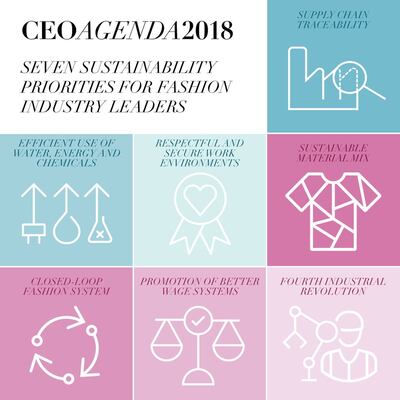
The Business of Fashion
Agenda-setting intelligence, analysis and advice for the global fashion community.

Agenda-setting intelligence, analysis and advice for the global fashion community.

COPENHAGEN, Denmark — In the lead up to this year's Copenhagen Fashion Summit, the Global Fashion Agenda (GFA) — the non-profit sustainability forum that hosts the event — has debuted a new report detailing the seven sustainability priorities that should be top of mind for fashion executives today.
CEO Agenda 2018 highlights the key actions fashion needs to address now, which are broken down into core priorities that require immediate action and longer-term transformational priorities; it also offers advice and guidance on how to tackle the issues raised.

Created in collaboration with leading fashion companies that span luxury, fast-fashion and manufacturing — including Kering, H&M, Target, Bestseller, Li & Fung and Sustainable Apparel Coalition — the report will provide a framework for the summit in May. An innovation forum — a new addition to the Summit agenda for this year — will help connect brands with suppliers that meet the report's demands. "[It's] a precipitator of solutions," Eva Kruse, GFA president and chief executive, told BoF, describing the set up as something akin to a trade show.
The CEO Agenda project was born out of feedback from industry players who voiced concerns that the size and complexity of the issue of sustainability made it challenging to digest. "Our aim is that this document can actually help any CEO in the industry gain more clarity and prioritise what they should spend their efforts on," said Kruse. She added that it's important to target CEOs "because those decisions have to be made on the top floors of companies before it's ever going to be something that really drives the business forward." "It's really important to widen the conversation from a smaller group of companies to the rest of the industry," agreed H&M sustainability engagement manager Hendrik Alpen.
ADVERTISEMENT
"This is not a philanthropic quest," continued Kruse. "Of course, we want to preserve our planet and do better for the people working in it, but it is a CEO task because it has to do with business development."
BoF sums up the seven priorities for action towards a more sustainable fashion industry below.
Three core priorities for immediate implementation:
1. SUPPLY CHAIN TRACEABILITY
Many brands operate a complex and often fragmented supply chain, which makes it hard to track the source of raw materials used in products. This can be solved by plotting suppliers across the different stages of production. The report also recommends fashion brands publish a list of these suppliers to help increase transparency as well as encourage collaboration and stakeholder engagement.
2. EFFICIENT USE OF WATER, ENERGY AND CHEMICALS
Fashion's impact on global carbon emissions as well as water and chemical pollution is significant, from the chemical tanning of leather, to the processing of denim. Brands and their suppliers need to collaborate to track water consumption, energy and chemical usage, and pollution levels. This will help the implementation of efficiency programmes at the processing stage of the supply chain to reduce the use of resources and keep pollution output low.
3. RESPECTFUL AND SECURE WORK ENVIRONMENTS
ADVERTISEMENT
From dangerous working conditions to workplace discrimination, exploitation exists across all levels of the industry in a variety of shapes and forms. Companies should formalise respectful working conditions with policies that adhere to universal human rights.
Four transformational priorities for fundamental change:
4. SUSTAINABLE MATERIAL MIX
A brand's choice of raw materials can define up to 50 percent of its environmental footprint. Yet, there has been little emphasis on material innovation. Companies should increase their use of low-impact materials, such as organic cotton, and invest in the development of new, sustainable materials.
5. CLOSED-LOOP FASHION SYSTEM
Currently, the fashion industry is a long way off from a close-loop system: according to the report, 73 percent of the world's clothing ends up in landfills, while less than 15 percent of clothes are recycled and less than 1 percent of material used to produce clothing is recycled into new clothing. Design and product development teams at fashion brands should be trained to create product with the long-term in mind by designing items that are durable and easy to disassemble and recycle.
6. PROMOTION OF BETTER WAGE SYSTEMS
A significant driver of economic health and employment, the global fashion industry employs 60 million people along its value chain, according to the report. However, wages in garment production countries are often inadequate and do not provide for workers' basic needs. Companies should ensure suppliers adhere to local law wage requirements and explore how they can support better wage systems.
ADVERTISEMENT
7. FOURTH INDUSTRIAL REVOLUTION
Technology has long been a key driver of change in fashion. While digitisation has provided a number of solutions, exactly how it will impact the future of fashion is still unknown — and hard to predict. It is estimated, for example, that in some countries automation could replace up to 90 percent of garment worker jobs. Companies need to analyse how technological advances may impact workers across supply chains and consider this when employing new technologies.
Related Articles:
[ At Copenhagen Summit, Turning Sustainability Commitments Into ActionOpens in new window ]
[ What Trump’s Climate Reversal Means for the Fashion IndustryOpens in new window ]
The industry needs to ditch its reliance on fossil-fuel-based materials like polyester in order to meet climate targets, according to a new report from Textile Exchange.
Cotton linked to environmental and human rights abuses in Brazil is leaking into the supply chains of major fashion brands, a new investigation has found, prompting Zara-owner Inditex to send a scathing rebuke to the industry’s biggest sustainable cotton certifier.
Over the last few years, the run-up to Earth Day has become a marketing frenzy. But a crackdown on greenwashing may be changing the way brands approach their communications strategies.
This week, Sephora announced plans to double down on ‘green’ and ‘clean’ product labels, leaning into an increasingly risky marketing tactic even as a greenwashing crackdown has prompted other brands to pull back.